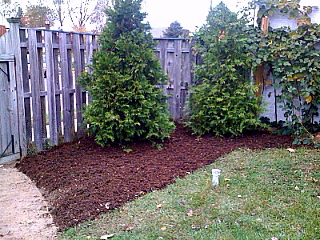It's not B.S.
Our favorite way to compost is using rabbit manure. All gardeners know how important compost is to the health of their soil. But our garden demands more compost than we can produce just using kitchen scraps, yard trimmings, and leaves. Last year, my husband started searching around for locally available compost materials, and he struck gold. On Craigslist, he found an ad for free rabbit manure about 30 minutes from our house. The manure came from a rabbit hobbyist who kept about 20 rabbits for breeding and showing. The first trip there got us 20 bags of manure, about 40 pounds each. We stuffed it in our little car and were giddy with our good fortune. We took several trips there over the summer and composted the manure with the pine bedding material they used in the trays under the cages.
My husband kept hunting, hoping to find a closer source. Eventually we found some a few miles from home. All of the sources use some kind of brown materials, such as straw, sawdust, or pine shavings. Hay and alfalfa pellets are also mixed in, as the rabbits end up dropping a lot of their food through the cages. Most weekends, we take a trip to fill up our plastic bins. The hobbyists are grateful to have someone pick up the perpetual supply of manure, and we love getting free stuff to enrich our garden. There is lots of praise for rabbit manure on the Internet, and it's even sold on eBay! Many say it's not necessary to compost it before using it. The idea is that rabbit manure does not burn plants and acts as a "slow release" fertilizer as it breaks down. However, we prefer to let it cook for a while to ensure that any pathogens and weed seeds are killed. Composting it also gives the mixture a nice color and texture.
Step 1: We collect the manure and browns into bins. Some of the rabbits are bigger than our 8 pound dog, Riley!
Step 2: We dump the mixture into one of our compost bins, wetting each layer lightly. We toss the mixture and break up any clumps. Sometimes, we add food scraps, grass clippings, or shredded leaves to the pile.
Step 3: After the bin is full, we cover it with black canvas; plastic might work better. It heats up in the next few days to about 150 degrees. The pile starts to cool down after about a week, and my husband turns the pile by moving it in to an adjacent bin. It heats up again, and after another week, he turns it.
Step 4: After a few turns, the compost stops heating up. The color changes to a deep brown. At this point, about a month has passed, and we use it for mulch on top of our beds. In the winter it takes closer to six weeks to cook a batch, but in any case, we typically use it before it's completely broken down. It keeps weeds down, helps hold moisture, and as it breaks down further, it feeds the soil.
I have also added manure pellets directly around plants. The manure mixed with wood shavings takes on a light brown color and takes longer to break down. We prefer a manure-straw mix, but it's not always available. However, we may try a sawdust mixture based on Barbara Pleasant's blog suggesting that sawdust is a great mulch for blueberries.
We use the rabbit manure mix as mulch for our vegetables, on our flower beds, berries, and around our trees. Below, the bed around our Green Giant arborvitaes is mulched with 10 layers of newspaper topped with several inches of our rabbit mix. It looks great and is a lot healthier for the soil than purchased wood chips.
Here is our blueberry hedge, mulched with rabbit mix, early spring 2013.
Pepper bed, newly mulched with rabbit mix, June 2013











No comments:
Post a Comment